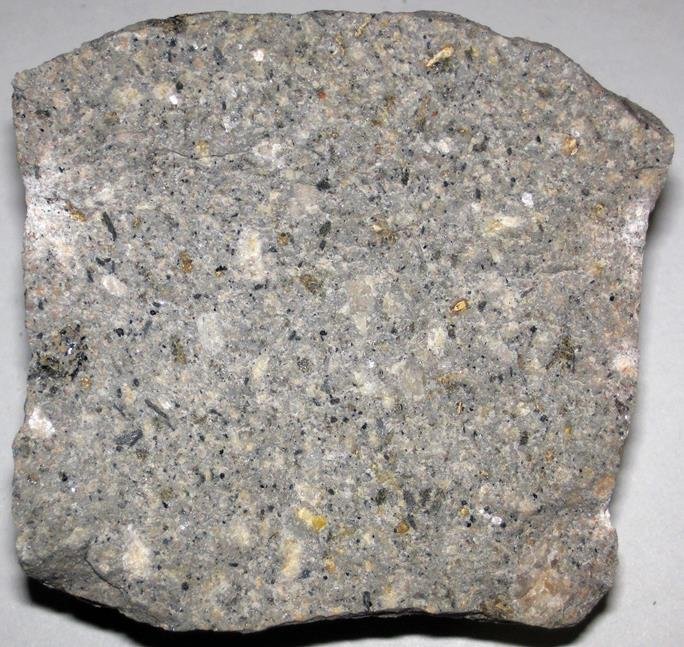Porphyritic andesite rocks have large, well-formed crystals or phenocrysts of mostly plagioclase and, less often, hornblende and pyroxene. Less common phenocrysts are biotite, apatite, ilmenite, magnetite, and titanomagnetite, with quartz rare.
These phenocrysts occur in fine-grained matrix or groundmass. The groundmass has mostly plagioclase with a smaller amount of pyroxene, hornblende, and sometimes alkali feldspar, biotite, muscovite, and glass.
Usually, the groundmass is more sodic than phenocrysts, and quartz and tridymite are interstitial.
Common accessory minerals in the groundmass include apatite, ilmenite, zircon, magnetite, and garnet.
The plagioclase in andesite is sodium-rich, especially andesine to oligoclase, and pyroxenes are clinopyroxenes like augite, diopside, or pigeonite, and orthopyroxenes, especially enstatite.
Porphyritic is an adjective from the noun porphyry, which refers to rocks with two distinctive grain sizes, i.e., bimodal grain sizes.
You can suffix porphyry with a compositional name. In our case, this rock is andesite porphyry.

What does it look like?
On hand specimens, plagioclase will have the largest lighter or white phenocrysts, while mafic phenocrysts – pyroxenes, hornblende, biotite, etc., are smaller, darker, brownish, or black.
Plagioclase phenocrysts will show normal zoning with calcium-rich core and sodium-rich rims. However, some may show reverse, discontinuous, convoluted to oscillatory (with concentric rings) zoning.
Sometimes, it may have trapped glassy inclusions. Also, they have melting evidence along cleavage planes. This creates a sieve texture.
Any olivine phenocrysts are replaced by orthopyroxene, which may have olivine inclusions at its core, while orthopyroxene phenocrysts are often rimmed by pigeonite.
Some of the phenocryst present may depend on where the andesite occurs. For instance, continental andesite has biotite phenocrysts.
In some specimens, phenocrysts form clusters. Different minerals create a cumulophyric texture; if they are of the same mineral, you will have glomeroporphyritic andesite.
More about andesite and textures
Andesite is a fine-grained, light to medium-gray intermediate extrusive igneous or volcanic rock. Its composition lies between basalt, which is mafic, and felsic rhyolite.
Mafic rocks are basic (low in silica, i.e., 45-52 wt.% SiO2) rocks rich in iron and magnesium. In contrast, felsic rocks are acidic (silica-rich with >63 wt.% SiO2), with relatively high lighter elements like sodium, potassium, silicon, and oxygen.
Andesites are lighter than basalt but darker than rhyolite and are the extrusive equivalent of diorite, a plutonic rock.
Besides porphyritic, this fine-grained rock can also have other textures. For instance, they can have vesicular texture characterized by voids or pits called vesicles. If secondary minerals fill these vesicles, you will have amygdaloidal andesite.
Other textures are ophitic/subophitic or trachytic. Ophitic will have pyroxene and sometimes olivine or other minerals surrounding plagioclase laths. Subophitic is the texture of the plagioclase laths that are partially surrounded.
On the other hand, the trachytic texture will have subparallel aligned feldspar microlites (minute crystals). The alignment is in the direction of flow or compaction.
How does porphyritic andesite form?
Porphyritic andesite rock forms from a two-stage cooling history, i.e., a slow cooling rate followed by a fast cooling.
The first cooling stage is slow and deep inside the Earth’s crust. This slow cooling causes less nucleation and allows time for crystals to grow large, forming phenocrysts.
Less nucleation results from a low degree of supersaturation due to the slow cooling. This means that the crystals will be dispersed.
Also, these phenocrysts will have a well-formed crystal since most of the magma is liquid. Thus, crystals will grow unimpeded.
The second cooling stage occurs when magma with well-formed, large crystals rises and erupts or extrudes.
Upon erupting, the fast-cooling rate causes high nucleation rates due to supercooling or a high degree of supersaturation. However, crystals don’t have time to grow large. Therefore, they form a fine-grained or aphanitic texture.
Aphanitic texture has tiny crystals you cannot see or identify without a microscope.
You should know that two-stage cooling isn’t the only way all porphyritic rocks form.
Different nucleation and crystallization rates or crystallization before the eutectic composition is achieved are possible causes.
Where are andesite porphyries rocks found?
These rocks form where other andesitic rocks form as lava flows and shallow sills or dikes.
They are common in continental and island volcanic arcs above subduction zones. However, a small amount can occur on continental hotspots and rifts.
Porphyritic andesite is widespread in Arizona and Texas and occurs in New England, Massachusetts, and New Hampshire.
These rocks are found on volcanic arcs like the Cascade Volcanic Arc in North America, the Andes in South America, and the Central America Volcanic Arc in the US.
Uses
One common use of porphyritic andesite is that it is crushed to make aggregate railroad ballast, roading, subbases, fills, and other construction projects and dimensional stones.
However, this aggregate or gravel isn’t suited for concrete as it is higher in silica content.
Another use is the dimensional stone industry. It makes pavers, flooring tiles, sculptures, statues, and monuments.
Lastly, some andesite porphyries are associated with copper deposits. Also, filled vesicles may host valuable minerals in amygdules and vugs.
